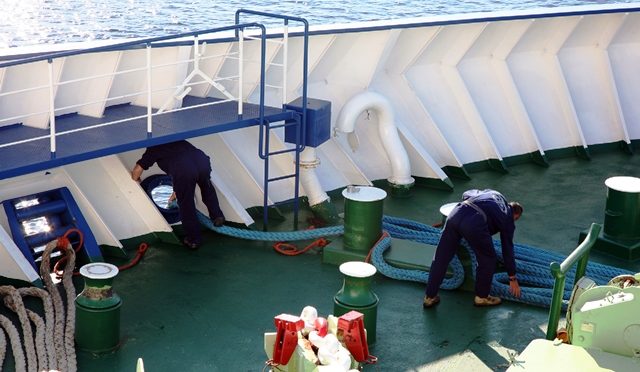Transport Malta has issued investigation report regarding a serious injury incident that happened onboard the vessel Vola 1, in the port of Vlothaven, Netherlands on 05 February 2016.
The Incident
Vola 1 arrived at Amsterdam on 05 February 2016 to discharge 12,600 tonnes of sunflower seed. A Dutch pilot, assisted by two harbour tugs, conducted the navigation of the vessel into Vlothaven. There was light to gentle breeze and the visibility was good. Shortly after the stern line was run ashore at 1730 (LT), the pilot instructed the ship’s master to let go the aft tug. The aft tug was fast to a single bitt using the tug’s line through the centre Panama fairlead.
The master relayed the instructions to the second mate who was in charge of the aft mooring station. The other crew members manning the aft station were a fitter, a motorman and two able seamen (AB). All crew members were wearing their protective clothing, including safety helmet, safety shoes and gloves.
The tug’s towline was slack. The messenger line attached to it was warped around the winch drum and held by AB 1. The second mate and AB 2 lifted the eye by hand. Before the eye was set free from the bitt, the towline became taut. The pull on the towline was unforeseen and sudden. The left hand of AB 2 was drawn with the towline and trapped against the bitt. At the time of the accident, the fitter was on the winch control panel and the motorman was handling the stern line.
Recommendations
The Maritime and Coastguard Agency’s Marine Guidance Note 308 (M+F) recommends good communication between the tug and vessel to ensure that instructions on towlines are understood at all times to avoid unexpected loads.
The UK’s Code of Safe Working Practices for Merchant Seafarers advises that it is not uncommon for the gear to become taut without warning and a number of accidents have occurred during the operation of making fast and releasing a tow. The Code recommends that before letting go, the vessel has to:
- establish positive communications with the tug’s crew and ensure that the tug has indicated that it is ready to receive the tow back;
- use the tug’s messenger line to heave in the slack and then stopper it off before taking the eye of the towline from the bollard; and
- take turns of the messenger line around the bollard to control the speed at which it is lowered and retrieved on board the tug; and
- make no attempt to handle towlines that have weight on them.
Navigation Maritime Bulgare is recommended to:
- Review ‘Shipboard Safety Operations’ manual and include a procedure on towing operations, securing and letting go of tug’s towline.
- Review Company’s formal risk assessment and identify control measures with respect to towing operations.
Further details may be found in the report herebelow
Source: Transport Malta
































































I read the report on the unfortunate injury of the AB involved in the release of the assist tug line. In researching the risks associated with these types of potential injuries, we have found that they are increasing in nature, especially when releasing tugs on the stern. Potential hazards include but are not limited to:
1) Tug lines are now typically stowed on winch drums where the line has a tendency to bury itself. With all good intentions, the assist tug operator may start to pay out the winch to provide slack however the line will in turn tighten due to being buried in the drum.
2) Modern day tugs can often be found with no deck hand on deck assisting with communications and line handling when retrieving the line. This is attributable to a false sense of operational efficiency associated with the tug operator being in control of a winch. On the stern, the operators visibility is often not ideal thus winch activation at the wrong time leads to undesired consequences.
3) Modern day tugs require trained operators with a good grasp of the maneuvering characteristics of the tug as they handle differently than conventional twin screw tugs. If you witness erratic handling of the tug while mooring, be extra cautious letting the line go. Insist the tug is in position under the chock (where possible) prior to letting the line go.
1) ALWAYS ENSURE THE MATE IS AT THE RAIL MONITORING ACTVITIES AND COMMUNICATING WITH THE ASSIST TUG AND MOORING CREW ON DECK. AS SOON AS THE MATE STARTS HELPING WITH THE LINE, NOBODY IS EFFECTIVELY MONITORING HAZARDS.
2) ALWAYS INSIST THAT THERE IS A DECK HAND ON THE TUG TO ASSIST WITH THE LINE HANDLING.
3) ALWAYS CONFIRM THERE IS SUFFICIENT SLACK IN THE TUG LINE PRIOR TO HANDLING – DO NOT SIMPLY RELY ON THE WINCH DRUM MOVING.
4) REQUEST THAT THE WINCH ON THE ASSIST TUG NOT BE USED TO RETRIEVE THE ASSIST TUG WHERE POSSIBLE.
Note that we have developed a messenger line concept that allows eyes of assist tug lines to be handled without having a crew member actually wrap their hand around the eye to place on/off bitt.